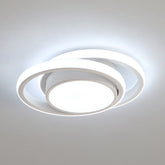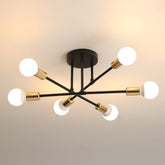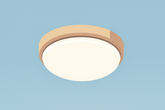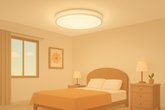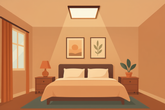Bedroom Ceiling Light Guide: Anti-Glare, Warm Light & Smart Dimming for Better Sleep
The bedroom is a sanctuary where you unwind and recharge. The ceiling light – the “guardian of illumination” – has a direct impact on both relaxation and sleep quality. Between warm light, smart dimming, minimalist design, and practical features, how can you choose the perfect ceiling light for your bedroom? This guide explores core needs, key parameters, and installation tips to help you make the right choice.
1. Core Lighting Needs: Comfort Meets Function
Unlike living rooms or kitchens, bedroom lighting focuses on creating a calm atmosphere while serving different functions:
- Sleep: soft, non-glaring light that promotes melatonin production and helps you fall asleep faster.
- Reading: targeted, even lighting to minimize eye strain.
- Grooming: high color rendering light to reveal true skin tones for accurate makeup application.
- Everyday activities: evenly distributed light for getting dressed, tidying, and organizing.
This balance requires more than just brightness—it’s about light quality, dimming flexibility, and suitability for your space.
2. Key Parameters: The Standards of a Quality Ceiling Light
(a) Luminous Flux & Illuminance
Luminous flux (lumens, lm) measures total light output, while illuminance (lux, lx) shows perceived brightness. Suggested values:
- Small bedroom (< 15㎡): 1500 – 2500 lm
- Medium bedroom (15 – 25㎡): 2500 – 3500 lm
- Large bedroom (> 25㎡): > 3500 lm
Aim for an average of 100 – 150 lx overall, with 200 – 300 lx for areas like the vanity or bedside.
(b) Color Temperature
Color temperature sets the mood of the room:
- Warm light (2700K – 3500K): cozy and relaxing, ideal for sleep and rest.
- Neutral light (4000K): close to daylight, bright yet comfortable for reading and daily tasks.
- Cool light (> 5000K): promotes alertness but is not recommended as main bedroom lighting.
Best choice: a ceiling light with adjustable color temperature via remote or mobile app.
(c) Color Rendering Index (CRI)
CRI indicates how accurately colors appear under the light. Choose CRI ≥ 80 for general bedroom use, and CRI ≥ 90 for grooming areas.
(d) Anti-Glare Design
High-quality ceiling lights reduce glare using frosted diffusers, recessed LEDs, or honeycomb grids. Check if LEDs are hidden and not directly visible from the side.
3. Installation & Maintenance: Quality in the Details
(a) Installation Tips
- Check ceiling load capacity and select the right mounting method.
- Ensure central alignment with a level to avoid tilting.
- Leave enough wiring length for future maintenance.
(b) Routine Maintenance
- Clean lampshades regularly (vacuum fabric shades, wipe glass or plastic with a damp cloth).
- Replace faulty LEDs promptly.
- Update smart ceiling light firmware for reliable performance.
Choosing the right bedroom ceiling light is a thoughtful balance of light quality, function, and aesthetics. With the right choice, every beam of light becomes a gentle companion for restful sleep and a more enjoyable daily life.
